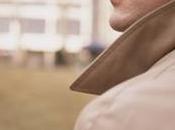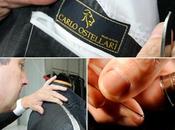
Straw Bale Cafe

Straw Bale Cafe

Straw Bale Cafe

Straw Bale Cafe

Straw Bale Cafe

Straw Bale Cafe

Rivestimenti in paglia

Straw Bale Cafe

Straw Bale Classrooms
Straw Bale CafèHewitt StudiosIl caffè ha un centinaio di posti e costituisce l’ampliamento di un edificio esistente, si configura non solo come semplice bar ma come un vero e proprio “social hub” per i fruitori del Campus. In pianta è visibile la differenza tra la parte vecchia dell’edificio, che è stata solo ristrutturata, e la parte nuova, totalmente in legno. Dall’esterno le due parti non si distinguono, poiché il rivestimento in doghe di cedro accomuna entrambe.
Gli studenti del College, inoltre, sono stati direttamente coinvolti fin dall’inizio nella progettazione e costruzione dell’edificio, avvalendosi dell’aiuto di alcuni studenti della School of the Built Environment dell’Università di Nottingham.
Per evitare l’impatto del cantiere all’interno del Campus universitario e ridurre i tempi di costruzione, si è deciso di

Un sistema low-tech che fa abbondante uso delle risorse naturali disponibili in loco. La paglia usata per l’isolamento – un sottoprodotto dell’industria agricola – arriva, infatti, dai campi limitrofi e dell’Università stessa, così come il legno del rivestimento esterno e della copertura, cedro rosso occidentale, che proviene dai 150 acri di bosco di proprietà del College.
Una progettazione attenta ha consentito di ridurre la produzione di rifiuti utilizzando materiali nelle misure disponibili ( utilizzo di pannelli di compensato della dimensione standard di 1200 mm). Il legname dei telai dei pannelli proviene da scarti dell’industria del legno. Ogni pannello è stato tagliato utilizzando macchinari CNC per minimizzare gli scarti riutilizzati poi nella caldaia a biomassa del College.

Il rivestimento a verde verticale delle pareti esterne è costituito da varietà indigene scelte in vivai della zona: minimizza l’impatto visivo del progetto, riducendo al contempo le emissioni di CO2 attraverso una migliore regolazione della temperatura e un maggior isolamento.
L’edificio, grazie anche all’elevata coibentazione fornita dalla paglia, necessita di poca energia per il riscaldamento e raffrescamento; l’energia elettrica è prodotta in loco attraverso una combinazione di pannelli fotovoltaici in copertura e turbine eoliche che permettono di generare oltre 5 kW di elettricità.
Architettonicamente lo Straw Bale Cafè è uno spazio contemporaneo dalle linee semplici e moderne che fornisce un modello accessibile per la realizzazione di edifici sostenibili. Tra i principali vantaggi del tipo di costruzione è la possibilità di poter essere smantellato con facilità alla fine della sua vita utile e molti componenti possono essere riusati e/o riciclati.
Il sistema costruttivo è brevettato dalla ditta inglese ModCell® ed è oggetto di un Programma Europeo di Ricerca per l’Eco-Innovazione Tecnologica, EuroCell.
Nel giugno del 2013, l’edificio è stato insignito del premio LABC Technical Innovation Award.
(Fabiana Cambiaso)
http://www.hewittstudios.co.uk
Immagini: © ModCell®; © Hewitt Studios LLP; © John Hewitt; © Paul Younger
Straw Bale Cafè, Herefordshire, UK
Hewitt Studios LLP, Bath, UK
Area: 187 mq
Completato: Ottobre 2010
Materiali: Legno, Paglia
Applicazioni: Involucro
English version
Straw Bale Cafe: wood, straw and innovation
This project comprises an extended 100 seat cafe, refurbished kitchen and cafe terrace. It is conceived as a learning aid in low-impact environmental design, featuring:
- Prefabricated Construction: To minimise disruptive on-site works, the building structure was prefabricated in a nearby barn.
- Demountable: The building is designed to be dismantled at end of 15 years and most components re-used / re-cycled.
- Energy efficient: The building is highly insulated, naturally ventilated and naturally daylit.
- On-site energy generation: The building generates up to 6kW from photovoltaic panels and wind turbine.
- Local Materials: Cedar cladding and organic straw from the College estate. Wall plants from local nurseries.
We chose to pre-fabricate the building structure, in order to avoid the need for certain lengthy and disruptive on-site processes. The Modcell load-bearing panel system was used. The panels were assembled in a ‘flying-factory’ in one of the College outbuildings by architecture students from Nottingham University and members of our practice. A key advantage of this modular form of construction is that the building can be easily dismantled at the end of its useful life and most components reused and/or recycled. This is important because the College has long-term plans for the redevelopment of the campus over the next 10-20 years.
Materials
The choice of materials has sought to make the most of the College’s natural resources. The 60 organic straw bales used to insulate the building come from the College’s own farm. The western red cedar cladding and decking was forested from the college’s 150 acres of woodland. This was cut to size on-site, by College contractors, just a few hundred yards from the building. The green cladding was planted by College students with learning difficulties, using indigenous varieties sourced from local nurseries.
Sustainability
Prefabricated.
The building structure was prefabricated using the ModCell load-bearing panel system in order to minimise environmentally disruptive on-site works.
Renewable
The building is constructed from renewable materials where possible, e.g: PEFC or FSC certified timber and straw (a by-product of the agricultural industry).
Local Materials
The building is constructed using local materials where possible, including organic straw bales from the College farm, western red cedar from the College estate and wall plants from local nurseries.
Low-Waste
Straw bales were cut to size in the College farm – trimmings were composted or used as animal bedding. The frame is made using offcuts from the timber industry. Cut waste was minimal, as each panel was precision cut from larger sheets using CNC equipment, but any waste was re-used the factory’s biomass boiler. Offcuts of aluminum and steel and were minimised by the design, but any offcuts were collected and recycled via the scrap industry.
Recyclable
The building is designed to be dismantled at end of its 20 year design life and most of components re-used / re-cycled.
On-site Energy Generation
The building generates up to 6kW of green electricity from solar photovoltaic and wind power sources. A monitor displays power generation statistics to the building users.
Energy Efficient
The building requires very little heating/cooling as the 450mm of straw bale insulation provides a u-value 3x better than current regulations require (0.14). The building is naturally ventilated and makes use of natural daylight where possible. All artificial lights are on motion and daylight sensors.
Carbon Sequestering
Each 3m x 3.2m prefabricated load-bearing panel sequesters approximately 1400kg of atmospheric CO2.
Green Wall
The green wall is planted with local varieties to enhance the biodiversity of the building. The ‘green’ cladding minimises the visual impact of the scheme, as well as reducing CO2 emissions through better temperature regulation and increased building insulation. It also reduces the amount of storm water run-off from the building.
Education
The building is designed as a learning aid in low-impact environmental design, having relevance to many of its students through their curriculum. College and University students have been be involved in the design, construction and ongoing maintenance of the building. A permanent display panel within the cafe tells the story of its construction.
(F.C.)





